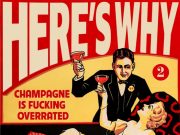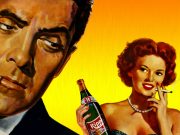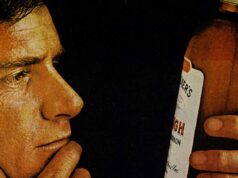The Volstead Act became law on January 17, 1920.
At the stroke of midnight, America was legally obligated to dry up tighter than a Pentecostal mummy. Supporters of this eighteenth of amendments to the Constitution celebrated (soberly) in the streets. The Women’s Christian Temperance Union (WCTU) and the Anti-Saloon League (ASL) trumpeted the birth of a new America, one in which every social ill, from poverty to vice, would soon be wiped from the face of the earth. America would stand forever more, head held high, on sturdy pillars of Christian Faith, Abstinence, and Industry. The future, according to the Drys, was bespangled with promise.
The Volstead Act scored a big goose egg, wish-fulfillment-wise; failure on a epic scale. By comparison, Michael Dukakis didn’t look a bit foolish sitting in that tank. What it did do, spectacularly, was showcase how the loudest and best-connected Few can dictate customs to the Many.
The WCTU, together with the even more obnoxious ASL, captained a propaganda juggernaut that plowed through all opposition (including a veto by then-president Woodrow Wilson) and made prohibition the law of the land. Their favorite tactics included casting shrill moral judgments at even occasional drinkers, rude suggestions that drinkers affronted God, and claims that the whole problem of drink was caused by Irish and German immigrants who infected innocent Americans with their disgusting European habits. Drys appealed to the avarice of the merchant-class, hypnotizing them with visions of mountainous wealth they could attain by forcing their workers to engage in more wholesome practices and thus increase their productivity. (Henry Ford used a secret security team to spy on his workers and report back on their off-hours activities. Any worker seen drinking was fired the next day. That sucks much ass, but not remotely as much as the fact that Ford engaged in these dirty deeds three years before Volstead.)
Prohibitionist clergymen (primarily of the Methodist and Baptist phylogeny) ranted against the “sin” of intoxication, claiming that drinkers imperiled their eternal souls. Secular activists infiltrated school boards in almost every state, where they successfully lobbied for legislation requiring all public schools to preach the evils of alcohol. Scientists friendly to the cause (who apparently spent their university time with their fingers in their ears yelling “la-la-la-la-la”) filled pamphlets and lecture halls with facts so decidedly un-factual they bordered on the surreal. (One doozy, put forth by a Dr. Robert Macnish, said that because drunkards retained so much alcohol they could spontaneously combust.) In short, the WCTU and the ASL waged a multifaceted attack on alcohol, and celebrated when, by all appearances, they won the war. Rounds of ice water, on the house!
Perhaps it goes without saying, but teetotalers were a bit premature in their rush toward self-congratulatory conga lines. Premature and flat wrong, actually, like saying Idi Amin was just lookin’ for a nosh. The madness lasted thirteen years before Reality showed up, pissed-off at being so grossly misrepresented, and bitch-slapped the Drys with Amendment Twenty One, repealing Volstead and decriminalizing alcohol. Prior to 21, though, prohibitionists kept plugging away, ferociously closing loopholes in the Amendment, and confronting backsliders with indignant howls.
There was no shortage of backsliders (let’s say “happy drunkards” and avoid perpetuating goofy and insulting dry-speak – look at me, ma, I’m double-plus dry!). More than a few people felt jackboots stomping their individual rights, flipped a snarky middle finger at the New Puritans, and kept right on drinking.
All they had to do was relocate their habits outside the law. In other words, they became Outlaws.
* * *
The Volstead Act took no one by surprise. It loomed on the horizon like a cloud of Old Testament insects for many months before its passage, and for many more while awaiting ratification by the States. Committed drinkers had ample time to ponder and plan.
More than a few enterprising gindogs recognized the approaching heap of legalistic yak scat for what it was, and diligently prepared for its smelly arrival. Their extra-legal adventures have become part of our national folklore. Called rum-runners or bootleggers by some, and simply criminals by prohibitionists, these folks actively worked against Volstead using a startling diversity of methods – bribery, trickery, and plain ol’ ingenuity among them. These outlaws made aqua vitae available to a populace disgusted by its sobriety.
Hand-me-down history usually points to mobsters as the primary movers of illegal liquor. While these “neighborhood businessmen” transported and sold vast quantities of illicit hooch, and committed many of the more garish murders in the 1920s, not every happy bootlegger was on Al Capone’s payroll. In fact, the biggest bootlegger of them all, George Remus (more on him later), had nothing in any way to do with the Mafia, and there were many other enterprising citizens who eschewed the Tommy gun in favor of less noisome – and more profitable – avenues.
Take, for example, physicians and pharmacists. They stepped up and did their part for drunkenness by taking advantage of a gap in Volstead that allowed doctors and druggists, after acquiring a special permit, to dispense spirits for medicinal purposes. Within months of Volstead’s ratification, 15,000 doctors and 57,000 druggists submitted license applications in Chicago alone, and by 1925 over 7,000 “soft-drink parlors” (selling snorts of medicinal whiskey) peppered the Windy City. In 1927 the nationwide allotment of medicinal whiskey topped 1.8 million gallons. One wonders if today’s medical elite would show similar gumption. Probably not. It might come between them and a summer cottage in Tahoe.
Another example comes from California’s wine community. Made up largely of family-owned vineyards at the onset of Prohibition, the industry got clobbered by the new legislation. Volstead contained a provision allowing churches to purchase small quantities of wine for sacramental purposes (they were urged to use grape juice instead), but that largess failed to live up to its billing. Profits from ceremonial wines and juices were nothing compared to those of unsanctified, sittin’-around-the-table wine. In an effort to recoup their losses, Napa Valley vintners (Beringer’s among them) began producing raisin cakes. Suddenly, instead of withering under Volstead’s hot glare, wineries leaped back into the black, their profits eventually soaring beyond even pre-Prohibition levels.
Described as snack food, or as a base for alcohol-free ciders, raisin cakes were allowed under Volstead, both to promote healthy, natural, beverages and as a stopgap to help Californian farmers avoid bankruptcy. They were wildly popular products for the obvious reason that by combining them with water, a jug, and a little time, they turned into a tasty vino. The vintners professed chagrin upon learning how their quality raisins were being used for illegal purposes, then outrage, and finally cried big sloppy crocodile tears and clutched their hearts. At the insistence of federal agents, the growers pasted history’s funniest warning label on their packaging—”Caution: Will Ferment Into Wine.” With their duty to propriety accomplished, then went right back to selling raisin cakes with thermonuclear glee. Their sales pitch ran along these lines:
Step right up ladies and gents! Step right up! Taste Nature’s bounty! Direct from California to you! Try our grape juice, the red or the white, and you’ll agree with the great chefs of New York and Paris that these are the finest juices ever to grace a dinner table. But take heed! America is rife with miscreants who misuse our wholesome confection. When availing yourselves of our most exquisite fruits, please adhere to the letter of the law and the tenets of your community. With your reputation in mind, we offer the following cautions. First, do not add any additional fruits to your cider, such as apples, pears, strawberries or blueberries, because such additions will alter the taste of the juice according to the amount of each non-grape used. Second, make your cider and drink it promptly. Do not, under any circumstances, place the juice in a jug, stopper the jug with a cork, and allow it to sit in a cool, dry place for eighteen to twenty-one days. If left unattended, juices will ferment into wine. And we wouldn’t want that to happen, would we? Step right up! Sample Nature’s bounty!
>
That’s art, right there. Grifter aesthetics.
Vintners winked at the buying public, and the buying public winked right back. The Prohibition Bureau estimated that between 1925 and 1929, Americans slurped up over 658 million gallons of home-brewed wine. Give a shout out to the lowly raisin.
And finally, no group trafficked in more illicit liquor than the bootleggers. Of them, the aforementioned George Remus was the acme, the Big Dog, the whipped cream, the Yoda, of all bootleggers.
After Volstead throttled the nation’s breweries and distilleries, millions of gallons of beer and hard liquor were left unused and rotting in warehouses, cellars, and on loading docks. The Act forbade selling leftover hooch to European or Asian buyers. Recognizing an opportunity when it poked him in the eye, Remus liquidated his entire life savings (some $100,000, earned as a lawyer and a pharmacist) and started buying “whiskey certificates;” hard-to-come-by Federal hall passes needed to sell “medicinal” spirits to drug companies. With the certificates came whatever stocks of liquor the original owner had in storage. Using his influential acquaintances, Remus bought certificates by the basketful, made a new fortune, and turned his attention to purchasing breweries and distilleries on an epic scale. By 1926, Remus owned more liquor factories than anyone else in the world.
Up to this point Remus had yet to break a single law. Nothing in Volstead prohibited purchasing or owning factories. So long as no liquor was produced, a guy could own as many as he wanted. No one batted an eye at Remus. But that changed in a hurry when he started buying drug stores and refitting them as wholesale distributors of medicinal whiskey. He sold the stocks of leftover liquor to his stores, then sold it as medicine back to himself and others through a nationwide network of dummy companies, everything carefully hidden in a web of whimsical accountancy that would give the slippery geeks at Arthur Andersen a collective stiffie.
By the late 1920s, George Remus controlled the movement of booze across the Midwest, and from Canada to Mexico. He had no production costs, since he was dealing in leftover product, and he poured money back into the operation, hiring drivers, accountants, salesmen, laborers, and nearly 300 operatives for his private security force. At one point, Remus carried over 3,000 employees on his payroll. He bought newer, faster trucks and cars, customizing them to hide sagging springs. He ran his operation from a walled compound in rural Ohio, on the outskirts of Cincinnati, but his representatives moved up and down the eastern seaboard and west into California. He was so big the mob couldn’t even begin to take him on.
Remus made millions and spread it around in the form extravagant gifts and huge bribes. At one of his many lavish parties he bestowed a new car on each of his twenty-three female guests. He regularly hid $100 bills under his guests’ dinner plates and sometimes dropped a diamond among the ice cubes in their drinks. His mansion, perched on a hill overlooking Cincinnati, had more square feet than any individual dwelling between New York City and Los Angeles. He bribed everyone. Prohibition enforcers were notoriously corruptible and Remus made several of Ohio’s very wealthy men. His records show that he bought local cops, chiefs of police, federal judges, mayors, senators, and the attorney general of the United States.
Contrary to his extravagant lifestyle, Remus cared for more than just money. He took great pride in selling quality, never-watered, liquor at a reasonable price. Later in life he would remind people that he never poisoned anyone with backwoods rot-gut. He resorted to violence rarely and only when provoked, and he thought most gangsters were brainless rubes. If we couple his lordly displays of wealth with his bookish personality, it’s no wonder F. Scott Fitzgerald modeled Gatsby on George Remus.
* * *
What’s the difference between an outlaw and a criminal? It might lie in the eye of the beholder, but it might also lie in the gray area between just and unjust laws. Criminals are content to break any ol’ law. Their illegalities are a form of greed, nothing more – purse-snatchers, Mafia hijackers, Enron executives. Outlaws, on the other hand, sense the spirit of the community and attack laws which inhibit it. Prohibition was a rotten law.
We are lucky, we drunkards. We have outlaws in our collective past. From such a robust lineage springs a rosier future.
Cheers.
—Richard English
(Note: the author is indebted to the works of Griffith Edwards and Edward Behr.)










